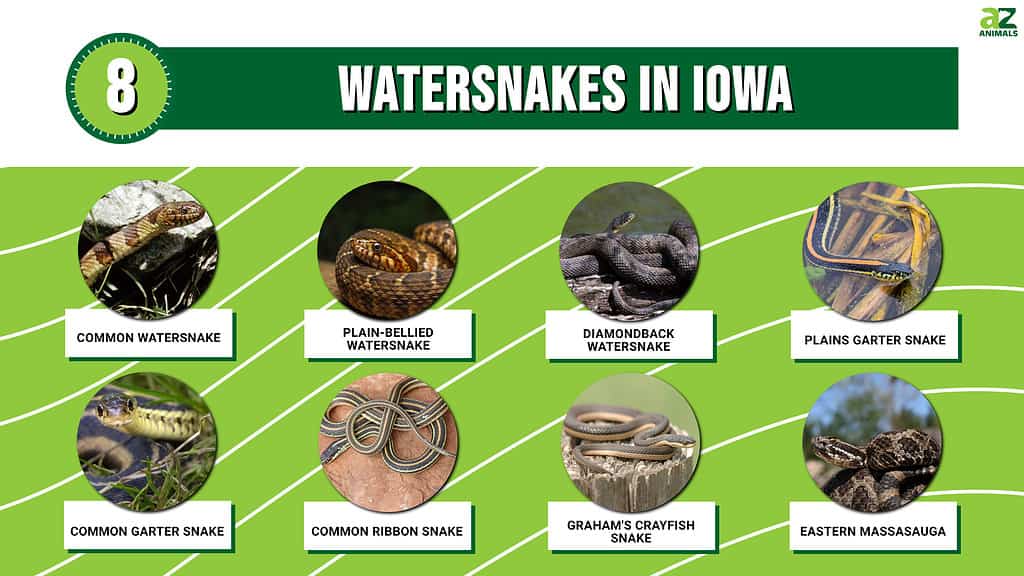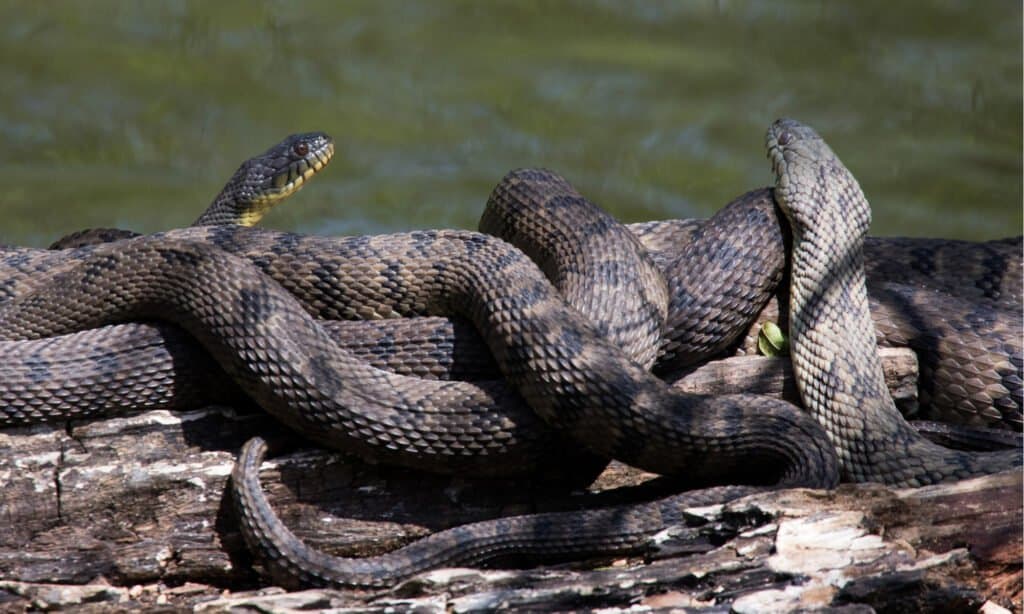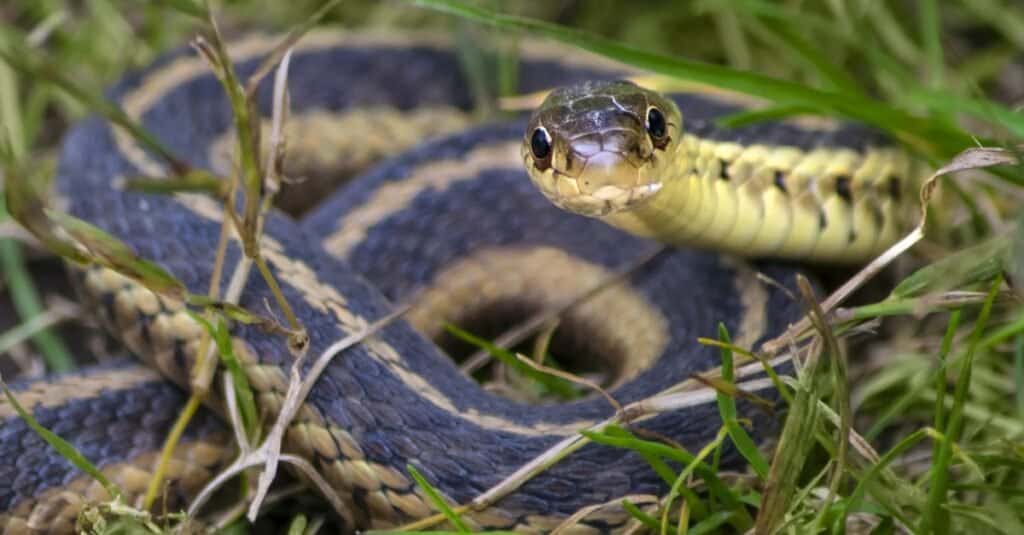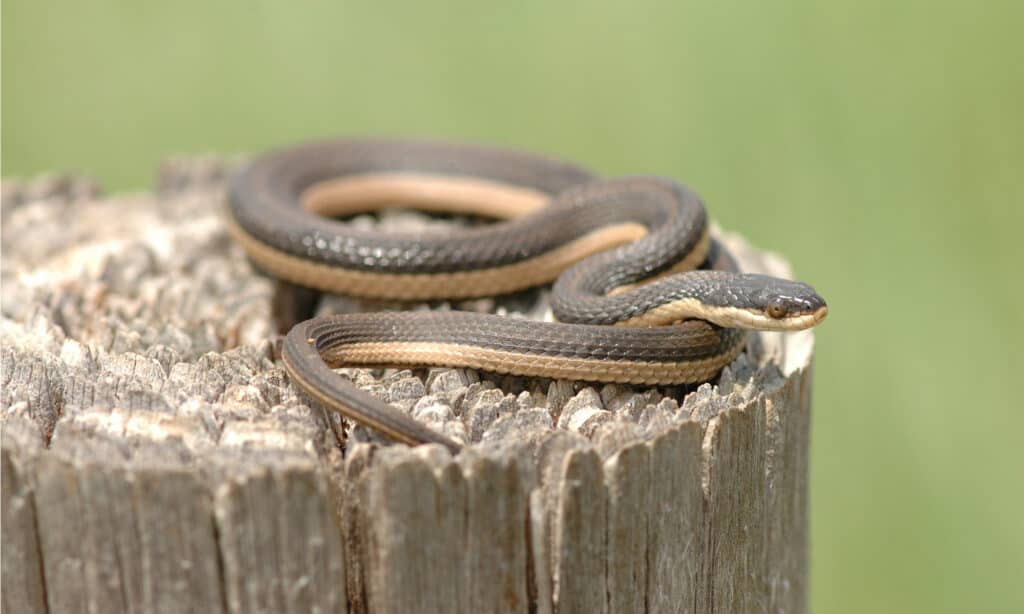With over 4,000 snake species worldwide, you can bet you’ll find a snake on every continent except Antarctica. Like the European adder, a few can even live above the arctic circle.
However, we’re talking about Iowa, the Hawkeye State! What it lacks in vipers, it makes up for in aquatic snakes. In addition, most of the state’s lakes are artificial and account for about 416 square miles, creating additional habitat for watersnakes.
Watersnakes in Iowa? You bet! We found eight snakes that spend more time in the water than the average snake.

1. Common Watersnake (Nerodia sipedon)

Northern watersnakes are the most common of all watersnake species.
©Patrick Coin / CC BY-SA 2.5 – License
The common watersnake has several names, including brown water snake and black water adder. They’re native to Iowa and inhabit eastern Iowa’s rivers and lakes.
These snakes sometimes reach four feet, but most stay smaller. Common watersnakes begin life with brighter markings that darken as they mature. Young snakes are usually gray or brownish with blotches on their bodies and crossbands on their necks. Adult snakes are generally so dark that seeing their pattern is nearly impossible.
Common water snakes eat amphibians, worms, tadpoles, fish, and crayfish. However, they’re not picky and will eat what they can catch.
2. Plain-Bellied Watersnake (Nerodia erythrogaster)

Young plain-bellied watersnakes have brighter patterns than adult snakes.
©Tyler Albertson/Shutterstock.com
Plain-bellied watersnakes are rare in Iowa, mainly in the southeastern reaches. Adults are usually identified by solid-colored bellies and faint chalk-line markings on their backs.
These snakes are native to the eastern half of North America. Plain-bellied watersnakes eat more toads and frogs in their diet, which reflects their habit of spending more time out of the water than other watersnakes.
Although they spend more time on the land, plain-bellied watersnakes are always near a permanent water source. This nonvenomous species is shy and does not want to tangle with you; they’re more likely to take off at the first sign of danger. However, watch out for their teeth! They have razor-sharp teeth that they’ll use on anything and anyone that scares them.
3. Diamondback Watersnake (Nerodia rhombifer)

Diamondback watersnakes
eat more frogs
, toads, and salamanders than other watersnakes.
©Laurie L. Snidow/Shutterstock.com
While they’re not as common in Iowa as the northern watersnake, diamondback watersnakes are in and around Iowa’s waterways.
Diamondback watersnakes are medium-sized and usually reach about three and a half feet long. They’re thick-bodied and typically dark gray to brown with roughly diamond-shaped black markings that some describe as a “chainlink fence” appearance.
This species tends to hang out on branches just above the water, where they watch for a meal in the water below.
Although these harmless nonvenomous snakes are primarily fish and frog eaters, they’ll also eat any small animal they can catch.
4. Plains Garter Snake (Thamnophis radix)

Plains garter snakes usually have a bright orange or yellow stripe on their back.
©Alyssa Metro/Shutterstock.com
Although you may not think of garter snakes as water snakes, they are semiaquatic. Pains garter snakes inhabit pretty much any place in Iowa with enough prey and shelter. They don’t always have to be near water, and you can often find them in empty lots in the city.
Plains garter snakes in Iowa have mostly dark greenish bodies with bright yellow dorsal stripes. Most of them also have a couple of yellow spots on their heads. They measure up to three feet and have long, thin bodies. Some people believe that plains and common garter snakes hybridize where they share territory.
These snakes eat anything they can overpower, mainly earthworms, slugs, and small amphibians.
5. Common Garter Snake (Thamnophis sirtalis and ssp.)

Garter snakes are harmless to people, but have mildly venomous saliva.
©K Quinn Ferris/Shutterstock.com
Garter snakes of some type are everywhere in Iowa and elsewhere. Some regions have denser populations than others, but these resilient and diverse snakes can live in some of the oddest places. They can also spend hours in the water, hunting small prey like fish and amphibians.
The Iowa Department of Natural Resources says there are two common garter snake subspecies: the eastern garter snake (T. s. sirtalis) east and the red-sided garter snake (T. s. parietalis) west. Unfortunately, the subspecies constantly crossbreed in Iowa and other areas, making it even more difficult to tell which species is in your hand.
Both subspecies are long, thin snakes. Eastern garter snakes are usually dark greenish-brownish bodies with light-colored stripes that can be yellowish, white, or orange; they average two to four feet long.
Red-sided garter snakes (not the same as the California red-sided garter snake!) look similar but have additional red bars that come up from the edge of the belly.
Although garter snakes have a Duvernoy’s gland, which is how some colubrids produce venom, they aren’t dangerous to people. At most, you could call it “toxic saliva if you’re a frog” because that’s one of their main prey sources. These harmless-to-people snakes usually eat worms, small amphibians, and slugs. They have mildly venomous saliva that affects their prey but not people. These snakes eat small mice and anything else they shove down their throats.
6. Common Ribbon Snake (Thamnophis saurita)

Common
ribbon snakes
are versatile and can inhabit many environments.
©Creeping Things/Shutterstock.com
Members of the same genus as garter snakes, the common ribbon snake is also a watersnake. The species has bright yellow stripes over a dark brown base color and usually measures between 16 and 35 inches long.
Ribbon snakes in Iowa and other areas are diurnal and do most of their daily hunting using auditory and visual senses. These snakes are rarely found far from water and are common near lakes, ponds, and marshes. This species eats various small amphibians, fish, and other small prey.
These harmless snakes are more common in the eastern half of Iowa in wet areas with enough shelter and prey.
7. Graham’s Crayfish Snake (Regina grahamii)

Graham’s crayfish snake is commonly seen around ponds and other slow-moving bodies of water.
©Rusty Dodson/Shutterstock.com
Graham’s crayfish snake looks like a garter snake, which makes people believe that’s what they are. However, they aren’t in the same genus.
Throughout their range in Iowa, these tiny watersnakes love eating recently molted crayfish but, in a pinch, will also eat fish and amphibians. Graham’s crayfish snakes are small and only grow to about two feet long. They have dark backs with light-colored lateral stripes and occasionally a dorsal stripe too.
You’ll find these snakes in Iowa marshes and swamps, but they especially love drainage and irrigation ditches with lots of crayfish.
Their range includes most of Iowa, but sightings on iNaturalist.org are limited. However, that may relate more to their shy nature than anything else.
8. Eastern Massasauga (Sistrurus catenatus)

Eastern massasauga
rattlesnakes
are among the smallest rattlesnakes and enjoy wetter habitats than most rattlesnakes.
©Ryan M. Bolton/Shutterstock.com
The only venomous snake on our Iowa watersnake list isn’t technically aquatic. However, eastern massasaugas are more fond of marshy lowland areas than other rattlesnakes.
Massasaugas are among the smallest rattlesnakes and have smaller rattles that produce a higher-pitched buzz.
Adult massasaugas are only about 30 inches long and have gray to dark gray bodies with black oblong markings on their backs. Like other rattlesnakes, massasaugas have large heads with thin necks.
They’re pretty shy and avoid people but are big rodent eaters, so you’ll likely find them wherever there are rodents and shelter.
Other Snakes Found in Iowa
You’ll see more than just watersnakes around Iowa’s rivers and lakes. Over 20 snake species in the state range from dangerous rattlesnakes to harmless Dekay’s brownsnakes and everything in between. Here are a few:
- Prairie rattlesnake (Crotalus viridis)
- Western fox snake (Pantherophis ramspotti)
- Eastern milksnake (Lampropeltis triangulum)
- Eastern hognose (Heterodon platirhinos)
What to Do if You See a Snake Underwater
Unless you’re out herping, you’re not likely to see snakes — they’re more interested in avoiding people than encountering them! Additionally, most snakes would rather flee than fight.
So, if you spot a snake in the water, give it some space, and it’ll probably swim along and leave you alone.
Summary of 8 Water Snakes in Iowa
| Name of Snake | Length in feet | Diet |
|---|---|---|
| Common Watersnake | 4 | Most everything, but particularly amphibians, worms, tadpoles, fish, and crayfish. |
| Plain-bellied Watersnake | 2.5-4 | Toads and frogs. |
| Diamondback Watersnake | 3.5 | Most everything, but fish and frogs primarily. |
| Plains Garter Snake | 3 | Mainly earthworms, slugs, and small amphibians. |
| Common Garter Snake | 2-4 | Mostly worms, small amphibians, and slugs, but also mice and other tiny animals. |
| Common Ribbon Snake | 1.3-3 | Small amphibians, fish, and other small prey. |
| Graham’s Crayfish Snake | 2 | Recently molted crayfish, but will also eat fish and amphibians. |
| Eastern Massasauga Rattlesnake | 2.5 | Rodents. |
The photo featured at the top of this post is © Tyler Albertson/Shutterstock.com
Discover the "Monster" Snake 5X Bigger than an Anaconda
Every day A-Z Animals sends out some of the most incredible facts in the world from our free newsletter. Want to discover the 10 most beautiful snakes in the world, a "snake island" where you're never more than 3 feet from danger, or a "monster" snake 5X larger than an anaconda? Then sign up right now and you'll start receiving our daily newsletter absolutely free.
Thank you for reading! Have some feedback for us? Contact the AZ Animals editorial team.






